I was initially thrown by the waveform display, which reflects the levels of the underlying log-encoded raw data at all times. Due to the log encoding most of the data was compressed toward the middle of the dynamic range, which is typical for a log curve, but that made it difficult to see what was happening to individual objects, like faces. Over time I learned that all I had to pay attention to was highlight clipping. If I set the exposure by eye based on what I saw in the onboard LCD and then checked that the clipped highlights were the ones I expected to be clipped (there’s always something clipped in a dark forest, usually the sky), I knew I had more than enough to work with in post. And I really liked the quality of the clipped highlights: they were white but not zingy, electronic white, similar to what I see on the Canon 5D Mk. III.
Working solely off the LCD monitor while shooting in 4K was not optimal, but it was the only monitoring option available that fell within our budget and schedule. I don’t recommend it, but–as I show in this film–it can be done.
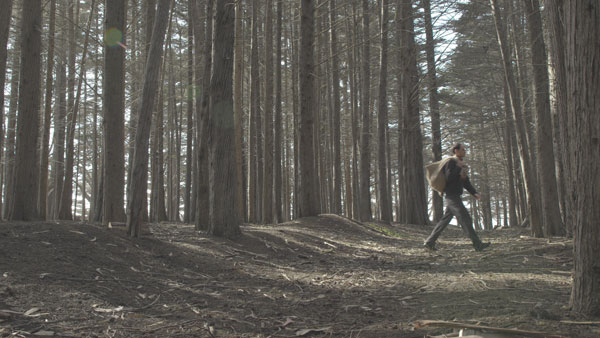
Before…
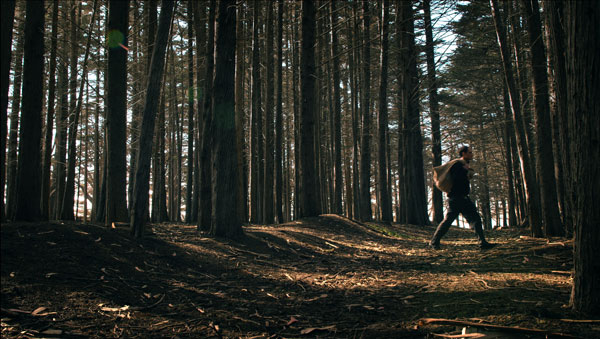
…and after.
The first three hours of the shoot saw us in sunny weather, but the last two hours were shot in soft sidelight as the fog crept in. The quality of the light was beautiful, almost creepy, which was exactly what I wanted for the end of the piece, but we did end up shooting at ISO 1600 and wide open on our lenses (T1.4/T1.5). I’m anxious to see how focus holds up at 4K; I’ve seen the footage projected on a 2k screen and it looks fine. Just after the shoot I did a rough dailies grade in Resolve Lite and discovered the increased noise at ISO 1600 wasn’t bad at all: in fact, during the grade at Spy, I saw no difference in noise between the ISO 800 footage and the ISO 1600 footage in the 2K projection in Spy’s DI theater.
I chose to obscure most of the digging as it’s important to not know what’s being buried until the end, but also because keeping things just out of view of the audience tends to keep them engaged. Humans are naturally curious, and it’s fun to toy with that innate characteristic by giving hints of what’s going on without actually spelling it out. This only works, however, as long as there’s a payoff–which there is, but you’ll have to wait until I post the entire movie to see it.
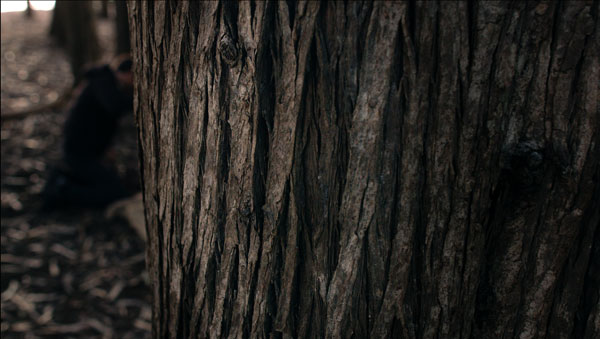
He’s burying something… but what? I chose shots like this to show off the amazing textures that can be captured in 4K.
I particularly like the shot where the front half of the mystery man is obscured behind a foreground tree. It’s a little bit like the scene in “Rosemary’s Baby” where we see through a doorway that Ruth Gordon is on the phone in the next room but we can’t see her face, which makes the audience want to lean around the door frame. In this case we can tell what he’s doing, but we can’t tell what he’s doing it to.
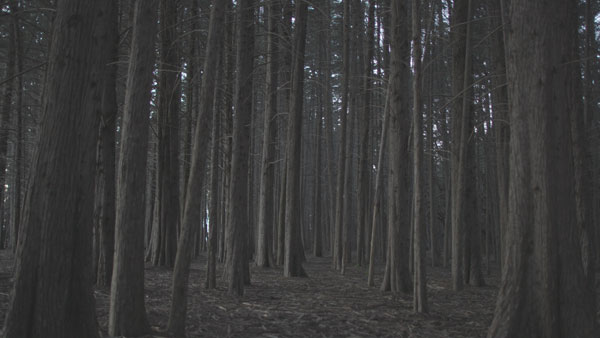
Before…
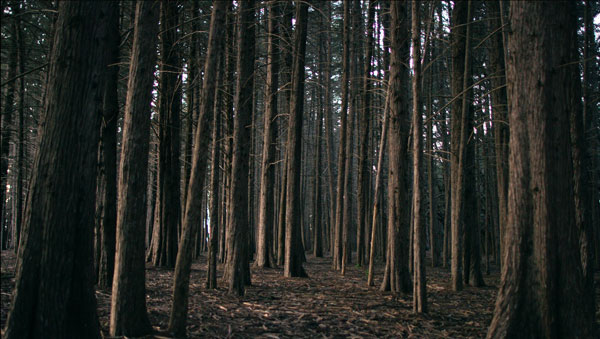
…and after.
The inserts of the trees “watching” the digging process were just grab shots that I picked up at the end of the shoot. I didn’t know how I’d use them, but I figured it would be better to have them than not. This is something I do regularly when shooting spots: once I understand the director’s vision I can grab extra shots if I see something appropriate and they’re off talking to the agency or the actor. I figure it’s better to have more than less, and they can choose not to use it if they don’t need it. At least one of these shots usually makes it into the edit, and in this case I’d say half of them did.
After I cut an initial assembly I asked my friend and frequent collaborator, director / editor Ian McCamey, to take a crack at it. He completely cleaned up my mess but cut two walking shots that I thought were really cool. “Sorry, I killed some of your babies,” he said when he emailed me an FCP project file, but he definitely made the piece a lot better by pulling out some excessive storytelling. I’ve seen some stellar shots fall by the wayside in my career, but almost any project is judged on its story, not on the individual shots, and if a beautiful shot doesn’t tell the story in the right way then off it goes.
As I mentioned previously, the grade was done by colorist Chris Martin at Spy in San Francisco. Owning a camera doesn’t make one a cinematographer, and Chris shows that the same is true of grading software: owning it does not make you a colorist. Together we developed a color arc for the story, starting out with warm sunlight offset by cool green shadows for an ominous feel followed by two more stages where Chris gradually removed the coolness in order to set the stage for a happy ending. He also added blue sky to a couple of shots, inserted some tasteful grads and even keyed flesh tones so that we could tweak them separately from the rest of the image. And he did it all really quickly. That’s what separates the adults from the children: anyone can create a look, but creating the right look quickly is the mark of someone who has truly mastered their craft.
I worry quite often about the current generation of filmmakers who are coming out of film school and immediately starting their own production companies. They’re missing out on so much knowledge by not spending some time at the bottom of the career ladder and seeing how seasoned professionals really do things. It’s a bit like telling a young director that they should bring on an assistant director for a complicated project, and they almost inevitably say, “It’s okay, I can do that myself.” No, you can’t, because if you’re supposed to be on set telling all of us what you need us to do you can’t possibly be getting actors into wardrobe and makeup, staging extras, juggling schedules, coordinating departments and dealing with SAG paperwork. Once they hire an AD for the first time it’s like a light turns on: “Oh,” they say, “I get it now.” The same thing happens when I work with a young company and I expose them to a seasoned grip/electric crew: they are amazed at how quickly we get things done. What would take them three days to shoot on their own we can do in a morning.
The same thing is true of a colorist. Sure, we can all putter around on our laptops and create some interesting looks, but it’ll take a fair amount of time and we’ll be limited in what we can do. That experience changes when you bring someone in who does nothing but grade things all day long. They’ll do it better and faster than you or I ever could.
At this point the plan is that Canon will show this short film as part of a 30 minute loop of 4K material in their booth at NAB. Please do stop by and check it out on a big screen. Sometime after NAB I’ll post it here as well. Right now I’m playing producer, running around trying to get footage from one place to another so that it can be tweaked in different ways. With any luck it’ll be finished and on its way to join Canon’s NAB showreel within a day or two.
Last but not least, I need to give Five Ten Chase a shout out. Our actor was wearing their shoes so I found myself in the position of having to obtain permission to show their brand in this short film. Once I reached the right person they immediately said yes, which was incredibly nice of them. I’m extremely grateful.
Be sure to read Adam Wilt’s review of the Canon EOS-1DC 4K HDSLR here on DVInfo.net, and look for his Canon C500 article that will appear in the April (NAB) issue of Film and Digital Times.
FTC 16 CFR 255 Disclaimer: I’ve received no compensation from Canon or Five Ten Chase for creating this project.
Behind-the-scenes photos are ©2013 Adam Wilt and used with permission.
03/26/2013
Art Adams
Director of Photography
www.artadamsdp.com
Twitter: @artadams
